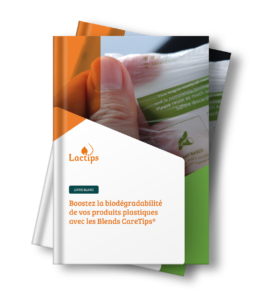To reduce the amounts of petroleum used by the plastic industry, there are several complementary strategies:
- Elimination of plastic unnecessary for essential needs
- Lightening of parts and packaging
- Integration of recycled materials (MPR)
- Use of bio-based raw materials
Here is an overview of bio-based alternatives to widely consumed materials such as PE and PP.
Bio-based Alternatives to PE and PP
Bio-based and biodegradable biopolymers
The most well-known bio-based and biodegradable polymers are PLA, PHA, and PBS/PBSA.
While PLA and PHA are 100%bio-based, PLA is only compostable under industrial composting conditions, whereas PHA is also :
- Compatible with home compost
- Biodegradable in water
- Biodegradable in soil
PBS is also compostable, at home and in industrial environments, but is not currently entirely bio-based.
| Biodegradable under what conditions? | Industrial compost | Home compost | Soil | Water |
| BioTPE (TPU, SEBS, etc.) | Some references | No | No | No |
| PLA | Yes | No | No | No |
| PHA | Yes | Yes | Yes | Yes |
| PBS/PBSA | Yes | Yes | Yes | No |
| PBAT/PCL | Yes | Yes | Yes | No |
| Cellulosic | Some references | Some references | Some references | Some references |
| Starch based | Yes | Yes | Yes | Some references |
Source: Presentation of NaturePlast during the Polyvia Materials Purchasing Day, organized in October 2021.
| New biopolymers resulting from R&D efforts
These materials are recent on an industrial scale, and the emergence of new formulations in the market requires sustained R&D efforts. Among these new materials, we find natural polymers based on proteins, cellulose, algae, as well as biocomposites made of bioplastic resin and plant fibers. |
Biopolymers exclusively bio-based
Caution: not all bio-based polymers are biodegradable!
This is the case for bioPE and bioPP, which are bio-based equivalents to PE and PP plastics. They have the same properties as conventional PE and PP, are potentially recyclable, and are also easy to process using traditional methods.
The only difference: they are derived from sugarcane, molasses, or vegetable oils rather than petroleum.
Bio-based, biodegradable or recyclable: which direction to take?
Use of bio-sourced materials, biodegradable substances, incorporation of recycled materials (MPR): industries cannot overlook these circular economy practices.
What material to choose as a substitute for traditional petroleum-based plastics?
What strategy to adopt when, for the same process, in the same market, several solutions are possible?
Let’s take the example of a food paper packaging
For this application, two major market transformers have chosen to position themselves on two very different solutions:
- On one hand, a 100% natural and recyclable solution;
- On the other hand, a 100% bio-based solution, not necessarily recyclable. The selection of materials thus largely depends on choices. These choices are motivated by both the company’s long-term vision, its environmental policy, and by techno-economic criteria!
| The chosen solutions also depend on geographic regions
The trends in selection between bio-based, biodegradable, and recyclable materials vary significantly depending on countries and local political choices. It is known that European regulations tend to favor recycling. This is not the case in the United States, as the country lags behind in available infrastructure. American regulations therefore strongly encourage the use of biodegradable materials, as the country has ample land available for composting facilities. Regarding available materials, there are also significant disparities. For example, some grades of PHA for films are only available in Japan, while Europe mainly has access to grades for injection molding. However, these trends are likely to evolve, as the bioplastics market is still young. |
Examples of companies that innovate and turn to bio-based materials
LEGO is switching from recyclable materials to bio-based ones!
This was big news in 2023. After 2 years of testing and experimenting with over 250 material variations, the world’s leading toy manufacturer, Danish company LEGO, has decided to abandon its mass production project of bricks made from recycled PET.
This decision is all the more surprising considering that the process had just been approved by the FDA and EFSA! So, what are the reasons behind this abandonment? LEGO simply adhered to environmental reality: after conducting a life cycle assessment (LCA), it appears that with current processes, carbon emissions would be higher when switching to rPET.
Instead of rPET, LEGO decides to focus on reuse, brick refurbishment, and also the use of bio-based plastics! Since 2018, a production line using bio-based PE has been in operation, and LEGO is also turning to PLA.
Coca-Cola is offering bottles made 100% from plant-based sources
In 2009, Coca-Cola introduced its “PlantBottle ™” a PET bottle partially bio-based, as it was made from bioMEG derived from sugarcane and petro-sourced terephthalic acid (PTA).
Since 2009, the group has continued to innovate, with technologies evolving significantly. The new prototypes produced in 2021 are now 100% plant-based. Firstly, the PTA used is manufactured from bio-based paraxylene (bPX), using a green chemistry process owned by the company Virent.
Secondly, Coca-Cola has partnered with the Chinese company Changchun Meihe Science & Technology to produce bioMEG from raw materials sourced from sawmills and by-products of the wood industry.
Lastly, the group is clearly committed to developing a supply chain, as Coca-Cola has authorized companies like Heinz to use the technology behind this new type of bottle.
Do you want to boost the biodegradability of your plastic products?



